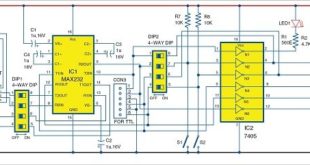Modern society requires much more outdoor lighting for a variety of needs, but the International Dark-Sky Association (IDA) advocates that any required lighting be used wisely to minimize the harmful effects of light pollution. If you’re looking for dark-sky–friendly lighting ideas and rules, see https://darksky.org/lighting/lighting-basics/. A lot has been published about the benefits of dark-sky lighting, including its key benefits like reduced light pollution and reduced energy consumption. In dark-sky lighting, shielded light fixtures are used so that no light is allowed upward into the night sky (no artificial skyglow) or into a neighbor’s place (no light trespass). You can learn more about the dark-sky movement at https://en.wikipedia.org/wiki/Dark-sky_movement.
Design idea
Naturally, I was inspired by the dark-sky movement and was challenged to build a little power garden/lawn light model that delivers decent illumination but zero vertical light escapes. Now I’d like to share one simple design idea that’s coherent with the definition of a shielded electric lamp. Here’s the circuit diagram of my garden/lawn light, which hopefully complies with the dark-sky lighting theme.
Retaining my casual habit of utilizing common and cheap (perhaps recycled) parts laying around, I rigged the system up with a handful of discrete components as shown in the circuit diagram. The component list included below surely makes it more perceivable.
| REFERENCE | PART | NOTE |
| T1 | S8050 | |
| T2 | S8550 | |
| T3 | S8050/BC547 | |
| D1 | 1N4007 | |
| D2 | 1N4007 | |
| LED1 | 8-mm Warm White | 80–100 mA/ 3v1–3v3 |
| LED2 | 8-mm Warm White | 80–100 mA/ 3v1–3v3 |
| LED3 | 3-mm White | 20 mA/ 3v1–3v3 (see text) |
| LED4 | 3-mm Red | 10 mA/ 1.6–1.8 V |
| ZD1 | 1N4734A | 4v3/1-W Zener Diode |
| R1 | 15K ¼ W | LED1 & 2 Brightness Limiter |
| R2 | 1K5 ¼ W | |
| C1 | 100 uF/16 V | |
| SWJ | Solder Jumper or SPST Switch | System On/Off Control |
| BAT | 3.7-V Li-ion | BL-5J Nokia |
| DC+ | Binding Post-Red | (see text) |
| DC– | Binding Post-Black | (see text) |
The design is optimized to work with a 6-V/3-W solar panel as the input requirement is a DC voltage not less than 5.5 V. The red LED (LED4) is the DC input indicator, while the two white LEDs (LED1 and LED2) work as the light source. The combination of transistors T1 and T2 drives those white LEDs when the DC input is unavailable or falls below a certain level (<3 V). The extra white LED (LED3) between T1 and T2 is wired deliberately to prevent deep-discharge of the 3.7-V Li-ion battery (BAT). This inclusion here allows the usage of unprotected, cheap Li-ion batteries as well. Similarly, the Zener diode (ZD1) is to inhibit a potential charging voltage surge in certain situations.
Finding What You Need
Note that there are two voltages to consider while choosing the solar panel: the open-circuit voltage (Voc), which is the maximum voltage that the panel will produce when there is no current plied by the panel, and the power-point voltage (Vpp), which is the voltage at which the maximum power is available from the panel. Much like voltage, there are two important values for current. The first is the short-circuit current (Isc), which is the maximum amount of current that a panel can deliver (it occurs when the module is shorted and there is zero voltage output). The second is the power-point current (Ipp), which occurs at the point on the curve where Vpp occurs and is the point of maximum power production for the module.
According to IDA, choosing LEDs for outdoor lighting applications involves a series of considerations and trade-offs. For example, IDA recommends warm-white (or filtered) LEDs to minimize blue emission as blue-rich white LED light sources are known to increase glare and compromise human vision, especially in the aging eye. Outdoor lighting with strong blue content is likely to worsen skyglow (http://www.darksky.org/assets/documents/Reports/IDA-Blue-Rich-Light-White-Paper.pdf) because it has a significantly larger geographic reach than lighting consisting of less blue!
Furthermore, a fixture that shields the light source to minimize glare is mandatory for the dark-sky–friendly light. What I like better is a fully shielded “barn light” enclosure (see next figure) for this project.
Sadly, I don’t have a 3D printer yet, so I visited a local scrapyard and gathered a medium-sized bowl (as the enclosure) and a circular reflector with a smaller diameter than the inside of the bowl. Because I’d completed the quick test of my breadboard prototype successfully, now is the time for a move from concept to completion. Needless to say, it might take a few weeks, but I’ll try to post photos of my finished project either here or on my social media page. I am still hoping that all will turn out well, and my article makes it easy for you to design, develop, and contribute IDA-friendly outdoor lighting projects and products!
In the middle of the experiment
This content was originally published here.








